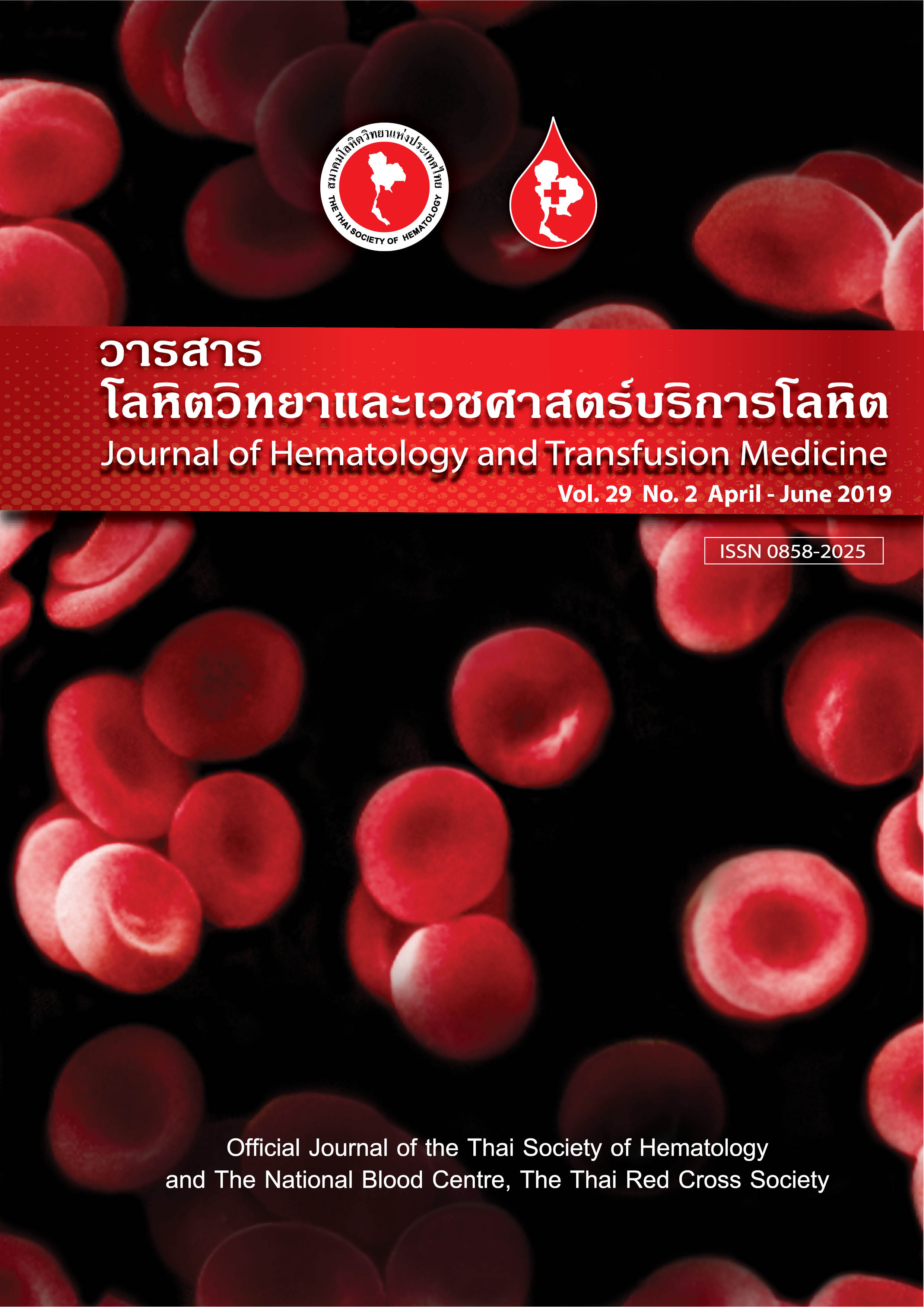การสร้างเซลล์สายพันธุ์ที่สร้าง anti-E โดยใช้เทคนิค human monoclonal hybridoma
Keywords:
Anti-E, Human hybridoma, Against Rh(E) antigenAbstract
บทคัดย่อ
ปัจจุบันน้ำยา anti-E ที่ผลิตโดยฝ่ายผลิตน้ำยาแอนติซีรัมและผลิตภัณฑ์เซลล์ ศูนย์บริการโลหิตแห่งชาติ สภากาชาดไทย ผลิตจากน้ำเลี้ยงเซลล์สายพันธุ์ที่นำเข้าจากต่างประเทศ ซึ่งอาจมีความยุ่งยากและสิ้นเปลืองค่าใช้จ่ายในการขนส่ง วัตถุประสงค์ เพื่อสร้างเซลล์สายพันธุ์ที่สร้าง anti-E จากเซลล์เม็ดโลหิตขาวชนิด B cells วิธีการศึกษา แยก B cells จาก buffy coat ของผู้บริจาคโลหิตที่สร้าง anti-E เพื่อนำมา transformed กับ epstein-barr virus (EBV) หลังจากนั้น screen น้ำเลี้ยง transformed cells ด้วย เซลล์เม็ดโลหิตแดงที่มีแอนติเจน E และนำ transformed cells ที่ให้ผลบวกมาทำการเชื่อมเซลล์ (fusion) กับเซลล์ human myeloma cells (JMS-3) โดยใช้ 50% polyethylene glycol จากนั้น screen น้ำเลี้ยง hybridoma cells ด้วยเซลล์เม็ดโลหิตแดงที่มีแอนติเจน E อีกครั้งและแยกเซลล์ที่สร้างแอนติบอดีให้เป็นเซลล์เดี่ยวด้วยวิธี limiting dilution เพื่อคัดเลือกเซลล์ที่สร้างแอนติบอดีได้ดี แข็งแรงและเจริญเติบโตดี หลังจากนั้นเลี้ยงขยายเซลล์เดี่ยว (monoclone) ที่ถูกเลือกแล้วให้ได้ปริมาณเซลล์และน้ำเลี้ยงเซลล์ตามความต้องการและเก็บรักษาเซลล์สายพันธุ์ที่ดีไว้ในไนโตรเจนเหลวเพื่อเป็นเซลล์แม่ พร้อมทั้งนำน้ำเลี้ยงเซลล์มาทดสอบทางซีโรโลยีต่อไป ผลการศึกษา สามารถสร้างเซลล์สายพันธุ์ anti-E ชนิด IgM จำนวน 4 โคลน ได้แก่ 4C91A2, 4C91B9, 4C91F9 และ 4C91G5 โดยมีความแรงกับเซลล์เม็ดโลหิตแดงชนิด R1R2 เท่ากับ 512, 256, 256 และ 512 ตามลำดับ ให้ผลบวกกับเซลล์เม็ดโลหิตแดงที่มีแอนติเจน E จำนวน 82 ราย (ร้อยละ 100 ) และให้ผลลบกับเซลล์เม็ดโลหิตแดงที่ไม่มีแอนติเจน E จำนวน 87 ราย (ร้อยละ 100 ) สรุป เซลล์สายพันธุ์ anti-E ที่ได้สามารถนำน้ำเลี้ยงเซลล์สายพันธุ์มาผลิตเป็นน้ำยา anti-E ได้อย่างมีประสิทธิภาพ เพื่อทดแทนและลดค่าใช้จ่ายในการขนส่งน้ำเลี้ยงเซลล์จากต่างประเทศ
Abstract:
Recently, anti-E reagents produced by National Blood Centre, Thai Red Cross Society, have high cost due to the expensive imported supernatant raw material. Objective: To produce human hybridoma secreting anti-E monoclonal antibody from human B lymphocytes. Materials and Methods: Human B lymphocytes from buffy coat of blood donor who had anti-E were isolated and subsequently transformed them with Epstein - Barr virus (EBV). Next, we fused the transformed secreting cell lines with human myelomas (JMS-3) using 50% polyethylene glycol (PEG) to produce hybridoma. We also investigated whether the hybridoma-secreting molecules could aggregate Rh(E) antigen on red blood cells. After that, we saved secreting clones by limiting dilution method. Following expansion of these hybridomas, we assessed the quality of supernatant in detail using serologic tests. Results: We established 4 different IgM cell lines stably expressing anti-E, namely 4C91A2, 4C91B9, 4C91F9 and 4C91G5, respectively. The titers of their antibodies with R1R2 cells were 512, 256, 256 and 512, respectively. These anti-E reagents reacted perfectly with E positive cells, whereas they did not react with E negative cells at all. Conclusion: This result indicates the fulfill quality of the current anti-E reagent. Although further serologic testing is required, our 4 different cell lines could stably produce anti-E reagent. This will substitute the use of supernatant raw material imported from oversea and will reduce financial cost in medical services in the future.
Downloads
References
2. Wiler M. The Rh blood group system. In: Harmening DM, editor. Modern blood banking and transfusion practices. 5 th ed. Philadelphia: F.A.Davis; 2005. p. 134-47.
3. Levine P, Stetson RE. An unusual case of intra-group agglutination. JAMA. 1939;113:126-7.
4. Landsteiner K, Wiener AS. An agglutinable factor in human blood recognized by immune sera for rhesus blood. Proc Soc Exp Biol NY. 1940;43:223.
5. Joy SD, Rossi KQ, Krugh D, O’Shaughnessy RW. Management of pregnancies complicated by anti-E alloimmunization. Obstet Gynecol. 2005;105:24-8.
6. Storry JR, Clausen BF, Castilho L, Chen Q, Daniels G, Denomme G, et al. International society of blood transfusion working party on red cell immunogenetics and blood group terminology: report of the Dubai, Copenhagen and Toronto meetings. Vox Sang. 2019;114:95-102.
7. Dean L. Blood groups and red cell antigens: the Rh blood group. [Internet]. 2005
[cited 2019 Apr 25]. Available from: https://www.ncbi.nlm.nih.gov/books/NBK2269.
8. Fongsarun J, Nuchprayoon I, Yod-in S, Kupatawintu P and Kidprasirt C. Blood groups in Thai blood donors. J Hematol Transfus Med. 2002;12:277-86.
9. Nathalang O. Laboratory indications and applications of antibody detection. J Hematol Transfus Med. 2018;28:115-8.
10. Goossens D, Champomier F, Rouger P, Salmon C. Human monoclonal antibodies against blood group antigens. J Immunol Methods. 1987;101:193-200.
11. Thompson K, Barden G, Sutherland J, Bel-don I, Melamed M. Human monoclonal antibodies to C, c, E, e, and G antigens of the Rh system. Immunology.1990;71:323-7.
12. Tingtoy U, Mekechay S, Deesin P, Tubrod J. Production of monoclonal anti-P1 by using hybridoma technique. J Hematol Transfus Med. 2017;27:11-8.
13. Boonhai S, Aiemumporn K, Tingtoy U. Production of a new anti-M monoclonal reagent using human hybridoma technology. Chula Med J. 2016;60:101-13.
14. Kerdkaewngam K, Posen S, Phonimit S, Tingtoy U, Phikulsod S. Generating the hybridoma cell line by murine monoclonal hybridoma technology for production anti-M and anti-N blood group phenotyping reagent. J Hematol Transfus Med. 2014;24:361-9.
15. Ponsen S, Phonimit S, Premprayoon N, Tingtoy U. Production of anti-D human monoclonal antibody (IgM) using human monoclonal hybridoma technique. Chula Med Bull. 2019;1:147-54.
16. Guidelines for the blood transfusion service in the United Kingdom. 8 th ed. Reagent manufacture [Internet]. 2013 [cited 2019 Apr 25]. Available from: https://www.transfusionguidelines.org/red-book/ chapter-11-reagent-manufacture/11-2-specifications-performance-evaluation-and-quality-control-of-blood-grouping-reagents.



